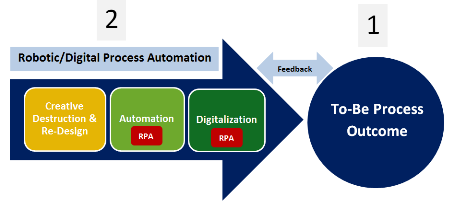Robotic Process Automation’s Next Big Step – IPA or Digitalization?

This summer another acronym emerged in robotic process automation (RPA) discussions – intelligent process automation (IPA). While adding to industry acronyms may not have been on everyone’s wish list, the fact is the technology isn’t static – so there’s no reason to expect terminology to be frozen in place either. But it is reasonable to judge new terms on the basis of whether they illuminate discourse, increase understanding, or engender confusion. By that standard IPA comes up short, yet intriguing, because use of the term does provide hints of major new innovation coming to robot automation and ushering new levels of capabilities and benefits.
IPA comes up short because there are few – if any – discussions which spell out how RPA technology could possibly meet the definition of an intelligent software agent (ISA) – and thereby earn the “I” – now, or even in the next five plus years. Central tenets of the definition are, “uses Artificial Intelligence (AI) in the pursuit of the goals of its clients.” AI, in turn, has “the capability to generate and implement novel rules of behavior”, and “analyze the information to find non-obvious or hidden patterns, extracting knowledge from raw data.”
The Significance of Digitalization
While RPA fails to meet ISA standards, leading robotic providers are rapidly developing functionality that qualifies for one element of the ISA definition: “Environmental modes of interaction are richer, incorporating the media of humans such as natural language text, speech, and vision.”
A popular term within the industry for this capability is “digitalization”, and it will make game-changing benefits possible by enabling robotic process automation to transform unstructured data: written natural language; images and speech – all of which are currently unsuitable for automation – into structured, digital, data which can be automated.
Digitalization capabilities will enable robotic software to not only automate business processes, but expand the power of automation by taking data formats common to human activities – e.g. talking and writing - and converting that information into formats suitable for automation scripts. Finally, at long last, software will begin to accommodate human behavior rather than humans continually accommodating the properties, complexities and limitations of software.
The applications of digitalization are game-changing because robotic software will move past mimicking human behavior to emulating human behavior. No longer limited to simply moving text from one location to another, it will derive a meaning or value from that text and base subsequent actions upon it. Robotic automation will be capable of powerful new interactive roles within automated processes, ones controlled by voice or language.
The new roles and capabilities of robotic software will expand the benefits of process automation beyond savings, performance and scalability and into high value areas such as customer experience. For the first time – armed with the power of digitalization – robotic process automation is able to not only impact operations but also influence sales and revenues by enhancing the customer experience.
The difference between customer service and customer experience is marked by proactive behavior shaped by highly responsive and personalized data. Amazon is perhaps the most well-known pioneer in the use of robust data to influence customer behavior and revenue generation. Certainly in the U.S. almost every adult has experienced how effectively Amazon uses information to enhance the customer experience throughout the sales cycle: from browsing to ordering; ordering to receipt of merchandise; and receipt through any transaction issues. Amazon even pioneered past the sales cycle; now customers actively recommend prior purchases and even answer product questions for other, prospective, Amazon buyers.
One adjective that gets to the heart of Amazon’s customer experience goal is “seamless”. Another would be “relentless”. The company continually and relentlessly innovates to elevate their customer experience. While this is great behavior for consumers, it poses two very significant challenges to other companies – those who are competitors and also those who aren’t.
The Amazon customer experience creates a common challenge across competitors and non-competitors alike by setting very high customer expectations – and doing so in a manner which strikes their customers as being essentially effortless. Of course it’s anything but effortless, but Amazon does bring a formidable advantage over many companies to the table; software, infrastructure and data architecture designed from day one for the customer experience and undisrupted by any significant acquisitions or mergers. By contrast, many industries have undergone rounds of consolidation, creating a patchwork of legacy technologies within the surviving companies.
Digitalization’s Impact on Process Automation
For the most part, the anchor of legacy environments on customer experience is tied to thin budgets, meager appetites for risk and the prospect of lengthy transition periods. Therefore the only way to meet the challenge of an Amazon customer experience is by influencing factors that can be controlled. That comes down to re-engineering prioritized processes and data flows in order to optimize customer experience within a strategic

approach. This re-engineering should be done in two steps: specify the to-be process outcomes and implement robotic/digital process automation.
Step 1: Specify the To-be Process Outcomes. Business stakeholders should have autonomy in determining the customer experience improvement required to significantly grow revenues. Then operational, strategic and IT stakeholders join business to articulate the process outcomes needed to create the new customer experience standard.
Step 2: Implement a 3-phase Robotic/Digital Process Automation Project.
These phases consist of:
Creative Destruction & Redesign: as the name implies, this phase is not about tweaking the existing process for automation. Rather, it is essential the existing process be subjected to the rigors of creative destruction. Any impediment to achieving process outcome goals must be challenged and, if necessary, escalated to the stakeholder group. Steps, roles, forms, business rules, data models must be re-designed from the ground up to lay a foundation for optimized robotic automation and digitization. Finally, the process operational model should be updated to reflect changes in roles, management structure, etc.
Robotic Automation: the automation design should reflect the minimum necessary process steps; simplified business rules and few, if any unavoidable dependencies.
Digitalization: this technnology should leverage an optimized data model, re-designed to fully leverage robotic automation/digitalization synergies and map directly to the customer experience requirements set by the business stakeholders.
It’s important to notice this methodology is the reverse of how process re-engineering and/or process automation typically occurs. In those instances, attention is focused on sequentially driving out inefficiencies at the task and activity level. The effort moves forward until the end of the process is reached and the cumulative improvement across the process is measured.
This methodology takes a zero-base approach: each step, role, task, rule, activity, etc. must justify itself in terms of the to-be process outcome target. When an action is justified but has properties or metrics which stand in opposition to the outcome target, only the stakeholder group – holding final responsibility for project success – has the authority to retain that action. This makes it difficult for vested interests or enemies of change to undermine the project.
This methodology also highlights the central role and broad impact of robotic process automation on processes when it has the dimension of digitization in play. It makes benefits possible that never were before.

Strategic Advisor, Tquila Automation
Get articles from automation experts in your inbox
SubscribeGet articles from automation experts in your inbox
Sign up today and we'll email you the newest articles every week.
Thank you for subscribing!
Thank you for subscribing! Each week, we'll send the best automation blog posts straight to your inbox.



